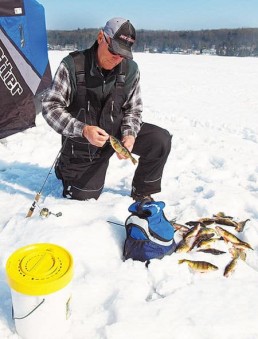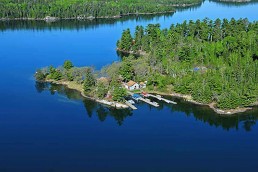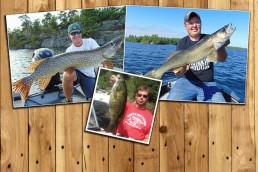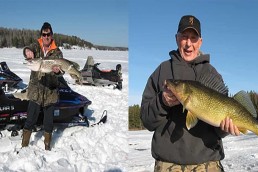There’s nothing small about Little Bay de Noc
Standing on the shore of Little Bay de Noc, an ice angler will quickly conclude there’s nothing small about this bay of Lake Michigan. And with over 30,000 acres of water to roam, as well plenty of forage to eat, the fish grow fast—thus trophy-size fish are common for all species that swim here.
Besides offering anglers who put the time in their chance at landing the fish of a lifetime, the water is home to a multitude of species. One could easily scratch a fish off the “never caught” list with ease in just one weekend here.
And it’s Little Bay de Noc’s large expanse of fishable ice and the plethora of fish here that makes this waterway one of the most popular ice fishing destinations in the Midwest. To boot, it’s also easy to travel to from the western states, as well its home state of Michigan and nearby Canadian providences. And it’s location on the northwest corner of Lake Michigan—with arctic lows creeping in over Michigan’s Upper Peninsula from the north—keeps air temperatures here on the cold side. This allows the bay to freeze early and thaw late; even during years like this, when El Niño keeps warmer Pacific weather patterns here. Some years, it can be one of the few Great Lakes destinations that see safe ice during mild winters.
Like all large bodies of water, the best way to pinpoint where to drill a hole and drop a line comes by breaking the portions of Little Bay down as if they were smaller bodies of water. And, although you don’t need to overdo the tackle you take with you, you’ll want a variety of lures and rods, as weather patterns may change the bite as well for you to match lures to your target species.
Spice of life
Before chatting about the gear needed to ice fish Little Bay de Noc, let’s cover the variety of fish species that make Little Bay de Noc their home base.
Anglers looking to catch walleyes have been fishing the bay for decades. This is because Green Bay and Lake Michigan’s ‘eyes migrate here to spawn once spring comes. In the angler’s favor, however, the fish show up here well before the urge to procreate overtakes, and they journey into the area to feed on the glut of forage.
Several rock-strewn reefs, weed beds and river mouths can be found throughout the system, and the walleyes move about all these structures while hunting for prey. And it’s also this prime structure that the walleyes use for spawning, which is some of the best in Lake Michigan’s entire ecosystem.
The yellow perch, a distant cousin to walleyes, also reside in the bay. The smallest perch are one of many food sources for predator fish. But anglers target yellow-bellies here because fish of 9 to 15 inches are frequently caught.
Another species that hunts down the smaller perch in the system are northern pike, and fish up to 40 inches are reported being caught every winter.
Two other highly sought-after gamefish that make their way into Little Bay every winter are lake trout and whitefish. Menominee (round whitefish), too, are sometimes landed.
Traversing the bay
Although there are some areas that can be ice fished on foot in winter, Little Bay de Noc is large enough that water quads or snowmobiles are required.
As winter wanes, cracks and heaves may form, and freighters may come into the port of Escanaba. Just take your time going to and from and you’ll be fine. And depending on where you launch from, travel is often several miles from your starting point. Just remember to take both a GPS and compass. These will not only help you get to your fishing spot, but safely back to shore.
What to take
Fancy equipment is not a must when fishing Little Bay. A medium-light ice rod and matching reel, the latter filled with 8-pound-test Superline coupled with a 6- to 8-pound-test fluorocarbon leader, will land any walleye, lake trout or whitefish that strikes. Also, take a light-action rod and reel filled with 6-pound-test monofilament for perch. And, a portable ice shanty, heater and snacks will keep you comfortable all day long.
Pike anglers, on the other hand, will use large, frisky suckers fresh from the bait shop and fish them under tip-ups. But don’t be surprised if you land a huge walleye on this rig too. Some of the largest walleyes of the season are landed on this when the bait’s fished high in the water column, even over deep water.
Whatever you do, never be afraid to move, even just mere feet, if you’re not catching fish on Little Bay. Search out cuts that come in from deeper water, and fish as close to the breaklines as you can. There are many reefs throughout the bay where predator fish linger as well.
One piece of equipment that can make or break your day here is a high-quality sonar (aka: fish finder) for determining depth and spotting fish. One that has a card-reader for a SD card filled with a hydrographic mapping program that shows contours and the like will help you pinpoint the exact areas for best fishing.
Special regulations
Unlike the majority of the Great Lakes, there is a season for targeting walleyes and pike that usually ends before the ice melts away—with that season closing being the end of the day on March 15. The other species that call Little Bay de Noc home however, are still open for the taking and still willing to hit.
Little Bay, big fish
This winter, give ice fishing Little Bay de Noc a shot. But don’t forget, there’s nothing small about this waterway, including the fish.
Break down the bay into lesser areas and fish them like they are smaller lakes. Don’t be afraid to move if the bite’s not happening for you, and change your approach often.
Class on Little Bay de Noc
For years now, walleye pro Mark Martin and his band of professional fishing instructors have been turning ice fishing into a fine art for students of the Ice Fishing Vacation/Schools, which are held throughout the Midwest.
Returning this year, the Mark Martin’s Ice Fishing Vacation School will be returning to the hoarfrost-covered water of Little Bay de Noc March 12 to 15. Here, students are taught, via seminars, from the pros as well as one-on-one in-class sessions and 2 1/2 days of on-ice fishing on the bay.
“Everyone learns something valuable at the Ice-Fishing Vacation/School, including myself,” says Martin. “Some come to the event just to be able to fish a huge body of water with others. No matter what, it’s a win-win for all of us.”
The experience costs $475 per student, which includes a tackle pack, bait and three full days of school. Room and board is extra, and snowmobile/quad rides to and from shore and fishing locations are available for a nominal fee. Each school is limited to only 25 anglers.
Check out markmartins.net and fishingvacationschool.com for more information.
MWO
SHARE THIS POST
You may also like...
Did you enjoy this post?
You can be among the first to get the latest info on where to go, what to use and how to use it!
Mark Martin
Mark Martin is a professional walleye tournament angler and instructor with the Ice Fishing School/Vacation series. For more information, check out his website at markmartins.net or fishingvacationschool.com.




